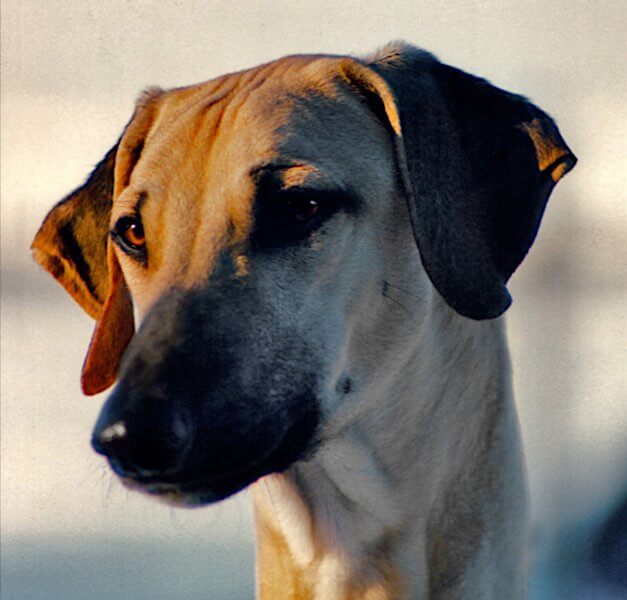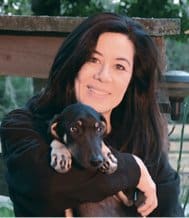Judging the Sloughi: Essential Components of Type
Sloughi history arose out of the shifting sands of the Sahara Desert in the North African countries of Morocco, Tunisia, Libya, and Algeria, a geographic region known as the Maghreb that is primarily inhabited by people of Arab and Berber descent. His exact origins are unknown, but the breed may date as far back as thousands of years.
Throughout the breed’s long history, the Sloughi’s survival has depended on his ability to course both large and small game (jackals, gazelles, boars, foxes, ostriches, hyenas, and hares), at length and over rough terrain, including desert sand, brush, and mountains.
The primary consideration in judging the Sloughi should always be his ability to hunt. A Sloughi must run on sound and strong running gear. In the countries of origin, Sloughis often trot for hours in the blazing sun before finding game and bursting into a gallop over varied terrain with the keenness, cunning, speed, power, and agility to take down their prey. He must have the strength of bone, jaw, neck, and topline to take down game of any size. And he must have the elegance of form to be both swift and agile to enable him to course game over long distances, with a dryness of tissues to allow him to exist in some of the most punishing conditions in the world.
This history and purpose should inform your general impression: “…a powerful and elegant, medium-large, short-haired, smooth-coated, athletic sighthound… a robust, but elegant and racy, pursuit dog with no exaggeration of length of body or limbs, muscle development, angulation, nor curve of loin. The Sloughi is not a fragile dog; it is a dog with class and grace.”
Even though the Sloughi has enjoyed full recognition in the AKC Hound Group since January 1, 2016, the breed remains one of the low entry breeds, and the majority of judges have not had the opportunity to see Sloughis in person. In addition, the AKC Sloughi Breed Standard was revised, effective as of August 8, 2022.
Sloughis share some characteristics with the Azawakh and with the Saluki. Nonetheless, preserving correct breed type is essential to protecting this rare and unique breed. Every act of judging either helps to preserve breed type or it contributes to its demise. The Sloughi is not a smooth Saluki or a variation of the Azawakh, and it should not look like one. Neither should it become a generic sighthound.
General Comments
The Sloughi hails from a land of harsh desert and rocky mountains to course all manner of game that can be found in Northern Africa. It should present as a tough, athletic dog with lots of speed and endurance, and each component of its conformation should speak to its purpose—it should have tough feet with hard nails, plenty of sturdy skeleton, lean muscles, an elegant but powerful neck, and strong teeth. Whenever an exhibit is presented to you, please consider whether this is a hound that could hunt in extreme heat for hours over rough, unforgiving conditions.

Body Proportions
A Sloughi should be very slightly taller than long, measured from the top of the withers to the ground, measured from the point of the shoulder to the point of the buttocks. Ideally, a Sloughi’s length from point of shoulder to point of buttock is 96 percent of its height. The ratio between depth of chest and height at withers should be ideally 4:10.
A Sloughi should never appear rectangular nor short-legged. These unique body proportions are a defining characteristic of the breed, and Sloughis who are apparently longer than tall, or who appear short-legged, should not be rewarded.
Height at the withers for males is normally 26 to 29 inches, for females it is normally 24 to 27 inches. Somewhat taller Sloughis are allowed, as long as they maintain the balance and agility required of a versatile coursing hound.
Open Angles
The Sloughi Standard uses the word “open” three times to describe front and rear angulation. This open angulation is necessary when considering the proper proportions of the Sloughi. There should be no sweeping bend of stifle or pronounced pigeon breast or set-under.
Ground-Covering Gaits
The Sloughi has a supple, smooth, and effortless gait with long strides, covering plenty of ground and reaching from the shoulders in front. This does not mean tremendous reach and drive. While an exaggerated “flying trot” should not be rewarded, short-strided, hackneyed, weak gaits, or gaits reaching only from the elbows, are also incorrect. Dogs who are out at the elbows or those having weak, floppy pasterns are particularly faulty. Hackneyed action is a serious fault. In addition, the Sloughi does not normally converge at the speed at which it is shown in the Conformation ring.
The American Sloughi Association has a judges’ education video on proper gaits in the breed at this link.
Robust but Elegant
The Standard says the Sloughi is a “robust, but elegant and racy, pursuit dog with no exaggeration of length of body or limbs, muscle development, angulation, nor curve of loin.” The Standard also uses the words, “powerful,” “strong,” and “sturdy.” Yes, the Sloughi is elegant, but the skeletal structure should be sturdy. The Sloughi should not appear fragile or delicate. The muscles and soft tissues should be strong and lean. The Sloughi is sturdier than many of its desert counterparts. This strength is needed for a dog that must often hunt over rocky terrain

Wedge-Shaped Head
The head of the Sloughi is unique among sighthounds. It has a long and elegant, sturdy, wedge-shaped head that narrows from the cranial region to the nose. The AKC Standard describes a backskull that is 4.75-5.5 inches wide between the ears. The Sloughi head is more substantial than many sighthound breeds. The occiput should be apparent, but not as pronounced as that of the Afghan Hound.
Ears
The ears are set slightly above the eye line, drooping, close to the head, medium in size, triangular, and slightly rounded at the tips… Disqualifications are ears erect, raised with tips drooping, or rose ears that cannot drop close to the head.
The Sloughi’s ears are set at about the level of the eye when the animal is at rest. When the animal is alert, the ears will appear to be higher on the head.
In addition, a rose ear is a disqualification in the Sloughi. Even Sloughis with excellent ears will fold them back when they are anxious, hot, bored, or inattentive. A handler can always show that an exhibit’s ears are proper upon request if they are correct. There are fifty shades of faulty between the ideal Sloughi ear and the disqualifying rose ear.
Color and Pigment
The coat colors are all shades of light sand (cream) to mahogany red fawn, with or without brindling or with or without black markings such as a black mask, black ears, dark overlay, and black mantle (black and sand or black and brindle). Blue, chocolate, solid black, and white Sloughis do exist, but they are disqualifications under the Standard.
A small white mark on the chest or small white marks on the toes are faults. White, anywhere on the body, due to aging or scars, is allowed. Disqualifications are: color not in accordance with the Standard, larger white markings, solid white extending above the toes, or white anywhere else on the dog except the forechest.
The nose must be black. Any nose color other than black disqualifies.
The nails should be black or pigmented. Brown nails and striped nails are acceptable. Depigmented nails or white nails are faulty. Any dog with a majority of white or depigmented nails is a disqualification.
Topline
The Sloughi’s topline is essentially level between the withers and the hip bones, but the highest point of the hip bones may be slightly higher than the withers, which should be apparent.
Body Condition
The Sloughi should always show defined bony structure and strong, lean muscles. The skeletal structure is sturdy. A Sloughi in good weight will have its hip bones apparent (but less apparent than those of the Afghan Hound), as well as the three rear-most ribs faintly visible. A Sloughi should look and feel hard and fit in the ring. The forechest should be bony and angular, and it lacks “fill.” The Sloughi should never be pigeon-breasted. It should never be soft in condition, and it should never appear padded.
Temperament
The Sloughi evolved as a coursing and hunting hound, but it also evolved as a guardian of nomadic tents and a sometimes livestock guardian. Part of the Sloughi’s purpose was historically to be suspicious of strangers and to be especially devoted to its family.
The Sloughi should be approached in a business-like fashion—never staring into the eyes; ask the handler to show the bite—front and sides, but never opening the mouth to check molars. Judges should refrain from speaking when bent directly over a Sloughi. If an exhibit is shy or nervous, please refrain from trying to comfort the Sloughi or talk to it, which will only heighten its suspicion.
Sloughis presented at Conformation shows must be comfortable enough to be examined, even if they are wary.
Disqualifications:
- Ears erect, raised with tips drooping, or rose ears that cannot drop close to the head.
- Nose pigment any color other than black.
- An overshot or undershot jaw.
- Coat too long and/or feathering on the ears, tail, and/or legs.
- Dogs with a majority of white or depigmented nails.
- Color not in accordance with the Standard, larger white markings, solid white extending above the toes or white anywhere else on the dog except the forechest.
For more information, please see the American Sloughi Association Judges Education Page online.
Sloughi Dog Breed Magazine
Showsight Magazine is the only publication to offer dedicated Digital Breed Magazines for ALL recognized AKC Breeds.
Read and learn more about the Sloughi dog breed with articles and information in our Sloughi Dog Breed Magazine.
Error embedding FlippingBook shortcode, please check the flipbook url. (https://digital.showsightmagazine.com/view/403841/)












